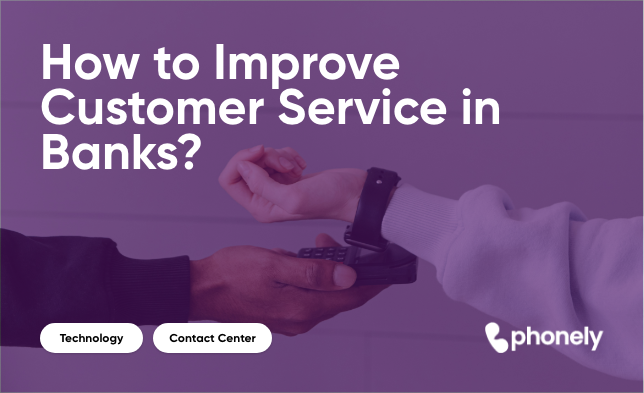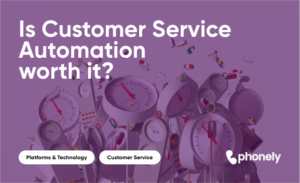Banking apps, smart contact centers, and automation with AI have traditional banks on their toes. As FinTech platforms release new financial management tools, expectations from traditional banks have shifted significantly. With an increasing demand for convenience and a rise in remote work, going to branch locations is not a viable solution for many. There’s also the added requirement to offer personalized financial advice to every single customer. Understanding and implementing these while building stronger customer relationships is no small feat, but it’s doable. This post explores these innovations and how you too can provide an exceptional customer experience.
Changing Customer Expectations
Customer expectations today look very different from what they were, even 5 years ago. FinTech platforms and NBFCs have set new standards for customer experience and service quality. Customers want to stay on top of their finances and make changes to their accounts whenever and wherever they like. In recent years banks have had to roll out new technology and processes to meet these demands and scale their customer service operations proportionally. Let’s see what this new change looks like.
From Branches to Digital Channels
Account inquiries, loan applications, and transfers were previously done in person. But now, its simply not the norm. Many people work remote jobs and often relocate or travel between cities, during which, access to a branch is inconvenient or even impossible. People want remote access to their accounts. Routine tasks like transferring funds, checking balances, and depositing checks should now be possible online. There is a whole app ecosystem dedicated to these services, and banks can not ignore this change.
Demand for Personalized Advice and Interactions
Digital access is only the first step. Customers at all income levels now want personalized services and interactions. A service that was previously limited to only high-net-worth individuals is now being normalized across the banking industry. People want their banks, and their agents to know who is calling along with their account information. They are also looking for personalized financial advice, based on their spending patterns and financial history. Top players in the industry are aware of this and are using AI to enable these en masse.
Real-Time Service and Convenience
Customers want to resolve their issues in real time. Banks no longer have the liberty to take days to provide resolutions. Additionally, customers need convenient access to their accounts and their services. This means managing their funds through mobile banking apps, asking for support using chat, and if possible, resolving their issues using self-serve options.
The Stakes for Banks
With such a high degree of innovation in the financial services industry, banks can not afford to stay behind. NBFCs (Non-Banking Financial Companies) with their nimble approach are rolling out tools and features at lightning speed. Alternate blockchain currencies like Bitcoin and Ethereum promise a more secure and transparent way of storing money. Yes, there is a certain level of risk involved with these innovations, but the advantages they provide are enough for some to ditch banks as a place for storing their money.
Along with staying competitive, banks are also responsible for upholding customer standards and trust. Many customers want this added convenience but only trust established banks to keep their funds safe. This means banks need to strike a balance between innovation and security; they can’t play fast and loose, unlike some other market players. Let’s see how you can tread this fine line.
Innovations for Better Customer Experience
Let’s go into how banks and other financial institutions are expanding their services and helping customers take control of their finances.
Mobile Banking App and Digital Banking Advancements
- Mobile Payments and Digital Wallets: Contactless payment options like Apple Pay and Google Pay are increasingly becoming commonplace. These features allow the user to send money to friends, pay bills, and transact in shops, all from one single app. These apps rely on a traditional bank connection but enable secure payments more conveniently.
- Real-Time Notifications: Digital banking apps are capable of providing real-time notifications to customers about their transactions, payment due dates, and suspicious activities. As a customer, these apps enable them to stay on top of their finances and report fraud as soon as an unauthorized transaction occurs. It’s more convenient and secure.
- More Convenience: Features like online check deposits, integrated financial planning tools, and instant loan applications make banking accessible 24/7. This leaves little need to visit a bank branch. Given the rise of remote work, these features can be a make or break for many.
Blockchain and Security Innovations
Payment and contract handling have also improved with the use of blockchain technologies. These give banks a secure and transparent way to record transactions.
- Faster Transactions: By reducing the need for intermediaries, blockchain enables banks to reduce processing times on transactions. This means that settlement time, international transfers and loan disbursement can happen in the blink of an eye. This speed is great for both banks and their customers.
- Fraud Prevention: Blockchain records everything. This means that all transactions and their ledger are tamper-proof. It’s nearly impossible to alter transaction data and commit fraud. Every action on the blockchain is recorded and verified by multiple nodes. This level of transparency and security is key to trust-building in high-stakes transactions like the ones in corporate banking.
- Biometric Authentication and Tokenization: Banks are also investing in biometric technologies like fingerprint scanning, facial recognition, and voice biometrics to verify customer identity. Tokenization during transactions helps banks encrypt customer information to further secure digital payments. Each token is unique, so the likelihood of customer data being leaked is reduced. Both these steps have made transactions quicker and safer for customers.
Open Banking and Personalization
- Deeper Personalization: Customers are using different apps and platforms to access and monitor their spending. Third-party integrations with customer consent have allowed customers to access their financial data in a way that they like to. Be it a trading app, a digital wallet, or a budgeting app, third-party integrations give users a choice to personalize their experience in whatever way they like.
- Expanding Financial Ecosystem: Open banking allows banks to partner with leading fintech companies and offer additional services like mortgage comparisons, insurance recommendations, or investment opportunities. Banks can use these pre-built ecosystems and offer more services without having to build a solution themselves.
AI and Automation in Banking
AI is changing how a bank functions both on the customer’s end and internally.
- AI-Powered Customer Interactions: AI has made banking more accessible and responsive for customers. Using Natural Language Processing, virtual agents can now take customer queries 24×7. AI agents can also manage routine transactions and even provide financial advice. Simple queries and requests no longer require human intervention.
- Robotic Process Automation (RPA): Even back office operations like data entry, transaction processing, and compliance checks are now automated. This means greater levels of efficiency that eliminate human error. These systems are relatively autonomous and can operate independently with little human intervention. This also allows banks to operate with a smaller customer service team, lowering operational costs.
- Reduced Wait Times: AI within voice systems and chat allows customers to get a quick response to their queries. Balance inquiries, password resets, and fund transfers don’t need bankers or human agents anymore.
Role of Contact Centers
The importance of technological advancements within the financial service industry can not be underplayed. Almost all banking services are now available in-app; additionally, many self-help topics are covered with an automated chatbot or help center. While this has reduced the role of bankers and agents in financial customer service, they remain important. Money and conversations around it require empathy and careful consideration. For this smart contact centers that combine human and AI agents are the only way forward.
Integrating Voice, Chat, and Email
Even over the phone, a customer appreciates the convenience. If calling from a registered number, they expect a frictionless experience with only the necessary amount of verification. By integrating voice, email, and chat support, you can ensure that the customer never has to provide more information than necessary to access and make changes to their account. Excellent customer service from a contact center must strike the balance between convenience and security. Calling into the bank should be approachable and safe for the customer.
Multi-Level Contact Centers for 24×7 Support
Providing 24×7 customer support requires multi-level contact centers that are a mix of on-site, virtual, and offshore teams. Use consistent training, software tools, and service standards to deliver a unified experience. Banking customers should not feel a drop in quality levels regardless of which agent they speak to. Audit these processes periodically to see if quality standards a maintained. Our post Build an Impactful Quality Assurance Process covers QA and its aspects in greater detail.
Optimizing Workforce Management
Workforce management (WFM) tools like Nice IEX and Five9 can help banks forecast demand and optimize staffing to meet these demands. You can also monitor real-time agent performance to see if you have an effective team in place. During peak call times, these tools are a lifesaver as they improve productivity and help maintain a high service quality.
AI-Driven Voice Assistants and Smart IVR
For calls that don’t require agent intervention, use AI-driven voice bots and smart IVRs powered by Phonely to handle routine queries. Phonely is highly customizable to your specific needs and can speak to a customer exactly how an agent would.
Voice Biometrics for Fraud Prevention and Authentication
Voice biometrics can help speed up the authentication process by identifying unique voice patterns in the customer’s voice. You would need to record a training sample initially but this combined with one more security measure can make authentication even more convenient and secure.
Data Analytics for Personalization
Data analytics within banks is also a growing trend. Both for customers and internal processes. This technology allows banks to de-risk themselves against lending, fraud detection, and cyber attacks. On the customer end, this data can help you deliver personalized financial solutions and anticipate customer needs based on their financial history.
Deliver Personalized Financial Solutions
Banks can use their CRM systems and analytics to provide personalized financial advice based on a customer’s transaction history and financial behavior. Providing these services at a scale no longer requires a bunch of bankers reviewing customer statements. With the right tool in place, all your financial services customers can get personalized advice.
Proactive Customer Engagement
Banks can use predictive analytics to anticipate customer needs and suggest relevant financial products to their customers based on their spending patterns before a customer even asks for them. For example, if someone is regularly transacting at BestBuy, you can offer them a credit card that helps them maximize rewards.
Key Performance Indicators (KPIs) in Banking Customer Service
Customer service in banking has become more complex, so to keep your processes in check; you need to know what metrics matter the most. These metrics will validate your wins and also point out any flaws in the customer journey.
Tracking Customer Satisfaction and Efficiency Metrics
- Customer Satisfaction Score (CSAT): CSAT is the most direct way to measure customer satisfaction after an interaction is completed. CSAT can be collected for chat, phone, and email interactions right after a ticket is closed. For sensitive issues like fraud, loan applications, and dispute resolutions; customer feedback is invaluable as it directly impacts customer retention.
- Net Promoter Score (NPS): Long-term customer loyalty is also crucial for banks. By asking customers how likely they are to recommend a bank or its products, you can understand customer sentiment and brand loyalty. In banking, trust is paramount, and NPS helps gauge customer satisfaction in the long term. A high NPS is a sign of consistent high-quality service throughout the customer journey.
- First Contact Resolution (FCR): FCR measures the percentage of customer inquiries and issues that were resolved during the first contact with the bank. This metric helps understand how adept agents are at resolving specific issues without the need for callbacks or escalations. A high FCR also reduces the need for follow-ups, and operational costs.
- Customer Effort Score (CES): Customer Effort Score measures how easy it was for a customer to resolve their issue. These can be administered at the end of an interaction, and customers and use a scale to rate the level of success. For a scale between 1 and 5, 4 and 5 count as positive outcomes, while 1 and 2 count as negative outcomes. Add these scores up and calculate the average, that’s your CES. The sum of all responses/Number of Responses.
Long-Term Customer Loyalty
- Customer Lifetime Value (CLV): CLV measures the total revenue that the bank expects to earn from a customer during their relationship. Exceptional customer service can open cross-selling opportunities to customers, thereby increasing the CLV. The more services a customer avials, the greater their lifetime value.
- Retention Rate: Retention rate tracks how many customers continually use their bank, year over year. High retention rates mean that the customer service and experience consistently meet customer needs. Looking at retention data along with service interactions can help pinpoint which services and experiences drive loyalty for the bank. This allows banks to make several business decisions about their technology and service offerings.
- Churn Rate: The churn rate measures how many people leave the bank over a given period. Monitoring churn after negative service interactions or bad PR can help identify patterns that lead to account closure. Proactive customer support measures during these times can help with customer retention.
Conclusion
Improving customer service within banking is not a one-and-done move. A really good mobile app or AI-powered financial advice is not going to fix customer service or experience by itself. With customers seeking convenience, the work that banks have to do is getting more complicated. Offering high levels of service means championing technological innovations, providing targeted services, and removing any friction during customer interactions. Keep convenience as the guiding light during this transition. If you can increase convenience without compromising security and trust; you will always exceed customer expectations.








